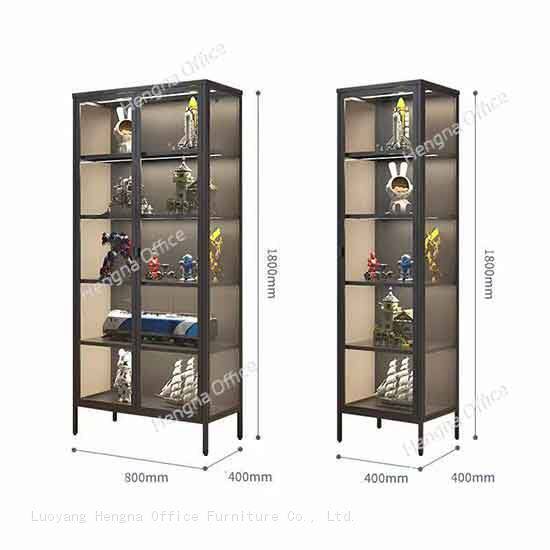Home > Blog > Elevate Dining Experience with Commercial Display Cabinets for Food & Wine Presentation
-
 Sarah
Hi there! Welcome to my shop. Let me know if you have any questions.
Sarah
Hi there! Welcome to my shop. Let me know if you have any questions.
Your message has exceeded the limit.

Elevate Dining Experience with Commercial Display Cabinets for Food & Wine Presentation
2025-10-30 17:08:15
In the competitive hospitality industry, the visual presentation of food and wine can significantly influence customer perceptions and purchasing decisions. Commercial display cabinets have evolved from simple storage solutions to sophisticated presentation tools that enhance dining experiences and drive revenue. This comprehensive exploration examines how restaurants, hotels, and food service establishments can leverage display cabinets to showcase their offerings, maintain food quality, and create memorable dining experiences that encourage repeat business. The Impact of Visual Appeal on Dining Decisions Visual presentation plays a crucial role in the dining experience, with studies indicating that customers often make dining decisions based on visual cues before even tasting the food. Well-designed commercial display cabinets create appetizing presentations that stimulate appetite and encourage additional purchases. The strategic placement of display cabinets near entrances, waiting areas, and dining spaces can increase impulse purchases by up to 25%. The psychology of food presentation suggests that customers perceive food as more flavorful and valuable when it’s displayed attractively. Commercial display cabinets that provide optimal lighting, temperature control, and visibility create premium perceptions that support higher pricing strategies. Understanding these psychological principles enables food service establishments to optimize their display cabinet investments for maximum revenue impact. Temperature Control and Food Safety Maintaining proper food temperatures is essential for both food safety and quality presentation. Commercial display cabinets incorporate sophisticated temperature control systems that keep hot foods at safe serving temperatures above 140°F (60°C) and cold foods below 40°F (4°C). These systems must maintain consistent temperatures even during peak service periods when doors are frequently opened. Advanced display cabinets feature dual-zone temperature control that allows different areas to maintain different temperatures simultaneously. This flexibility enables establishments to display various food types that require different storage conditions. The integration of digital temperature monitoring and alarm systems ensures food safety compliance and provides documentation for health inspections and quality control purposes.
 Lighting Technology for Food Presentation Lighting significantly impacts how food appears to customers, affecting appetite and purchasing decisions. LED lighting has become the preferred choice for commercial display cabinets due to its energy efficiency, low heat output, and superior color rendering capabilities. Warm lighting enhances the appearance of baked goods and roasted items, while cool lighting makes fresh produce and seafood appear more vibrant. The strategic use of accent lighting within display cabinets can create focal points that highlight signature dishes or premium offerings. Dimmable lighting systems allow establishments to adjust presentation throughout the day, creating different atmospheres for breakfast, lunch, and dinner service periods. Some advanced systems incorporate color-changing capabilities that can be coordinated with seasonal promotions or special events. Wine Display and Preservation Wine display cabinets require specialized features to maintain optimal storage conditions while showcasing bottle collections. Temperature control is critical for wine preservation, with different storage requirements for red, white, and sparkling wines. Humidity control prevents cork drying and maintains proper sealing, while UV-filtering glass protects wine from harmful light exposure. The design of wine display cabinets must balance visibility with preservation requirements. Angled shelving systems allow customers to read labels while maintaining proper bottle orientation. Some systems incorporate specialized lighting that minimizes heat generation while providing optimal bottle visibility. The integration of inventory management systems helps establishments track wine collections and optimize stock rotation. Customization for Different Food Service Concepts Different food service establishments require specialized display cabinet solutions tailored to their specific concepts and menu offerings. Bakery display cabinets often feature curved glass for maximum visibility and humidity control to maintain product freshness. Deli and butcher display cases may incorporate refrigerated display areas with specialized lighting that enhances the appearance of meats and cheeses. Hotel buffet operations require versatile display systems that can accommodate various food types and service styles. Mobile display cabinets provide flexibility for catering operations and special events. Fine dining establishments may opt for elegant, understated display solutions that complement sophisticated interior design while maintaining optimal food presentation conditions.
Lighting Technology for Food Presentation Lighting significantly impacts how food appears to customers, affecting appetite and purchasing decisions. LED lighting has become the preferred choice for commercial display cabinets due to its energy efficiency, low heat output, and superior color rendering capabilities. Warm lighting enhances the appearance of baked goods and roasted items, while cool lighting makes fresh produce and seafood appear more vibrant. The strategic use of accent lighting within display cabinets can create focal points that highlight signature dishes or premium offerings. Dimmable lighting systems allow establishments to adjust presentation throughout the day, creating different atmospheres for breakfast, lunch, and dinner service periods. Some advanced systems incorporate color-changing capabilities that can be coordinated with seasonal promotions or special events. Wine Display and Preservation Wine display cabinets require specialized features to maintain optimal storage conditions while showcasing bottle collections. Temperature control is critical for wine preservation, with different storage requirements for red, white, and sparkling wines. Humidity control prevents cork drying and maintains proper sealing, while UV-filtering glass protects wine from harmful light exposure. The design of wine display cabinets must balance visibility with preservation requirements. Angled shelving systems allow customers to read labels while maintaining proper bottle orientation. Some systems incorporate specialized lighting that minimizes heat generation while providing optimal bottle visibility. The integration of inventory management systems helps establishments track wine collections and optimize stock rotation. Customization for Different Food Service Concepts Different food service establishments require specialized display cabinet solutions tailored to their specific concepts and menu offerings. Bakery display cabinets often feature curved glass for maximum visibility and humidity control to maintain product freshness. Deli and butcher display cases may incorporate refrigerated display areas with specialized lighting that enhances the appearance of meats and cheeses. Hotel buffet operations require versatile display systems that can accommodate various food types and service styles. Mobile display cabinets provide flexibility for catering operations and special events. Fine dining establishments may opt for elegant, understated display solutions that complement sophisticated interior design while maintaining optimal food presentation conditions.
 Integration with Restaurant Operations Modern commercial display cabinets increasingly integrate with restaurant management systems to enhance operational efficiency. Inventory tracking capabilities help managers monitor stock levels and reduce waste through better ordering decisions. Some systems incorporate sales data that can inform menu planning and promotional strategies. The integration of display cabinets with point-of-sale systems enables automatic inventory updates when items are sold or replenished. Advanced systems may include customer behavior tracking that provides insights into which displays generate the most customer interest and sales. This data-driven approach helps establishments optimize their display strategies and maximize return on investment. Energy Efficiency and Sustainability Energy efficiency has become increasingly important in commercial food service operations, where display cabinets can represent significant energy consumption. Modern display systems incorporate energy-efficient LED lighting, advanced insulation materials, and smart temperature control systems that minimize energy usage while maintaining optimal food quality. Some display cabinets incorporate energy recovery systems that capture and reuse heat generated by cooling systems. The use of environmentally friendly refrigerants and sustainable materials in cabinet construction supports green restaurant initiatives and reduces environmental impact. These sustainability features can also serve as marketing points that appeal to environmentally conscious customers. Maintenance and Operational Considerations Commercial display cabinets require regular maintenance to ensure optimal performance and food safety. Cleaning protocols must address both interior and exterior surfaces, with particular attention to glass components that affect visibility. Temperature control systems require periodic calibration and maintenance to ensure consistent performance. The modular design of modern display systems facilitates maintenance and component replacement without disrupting service operations. Some systems incorporate self-cleaning features or antimicrobial surfaces that reduce maintenance requirements and enhance food safety. The consideration of maintenance needs during selection ensures that display cabinets enhance rather than complicate restaurant operations. Regulatory Compliance and Food Safety Food service establishments must comply with numerous regulations regarding food safety and handling. Commercial display cabinets must meet health department requirements for temperature control, materials safety, and cleaning protocols. The integration of temperature monitoring and documentation features helps establishments maintain compliance and provide records for health inspections. NSF certification and other industry standards demonstrate that display cabinets meet rigorous safety and performance requirements. The selection of certified equipment reduces liability risks and ensures that display solutions support rather than compromise food safety efforts. Regular staff training on proper display cabinet operation and maintenance is essential for maintaining compliance and food quality. Future Trends in Food Display Technology The evolution of commercial display cabinet technology continues to advance, with new innovations enhancing both presentation and operational efficiency. Smart display systems with IoT connectivity enable remote monitoring and control of multiple display units from centralized management platforms. Interactive displays that incorporate digital menus and promotional content create engaging customer experiences. Sustainability features continue to advance, with solar-powered display options and advanced energy recovery systems becoming more prevalent. The integration of artificial intelligence for inventory management and demand forecasting helps establishments optimize their display operations and reduce waste. These technological advances create new possibilities for food presentation and restaurant efficiency.
Integration with Restaurant Operations Modern commercial display cabinets increasingly integrate with restaurant management systems to enhance operational efficiency. Inventory tracking capabilities help managers monitor stock levels and reduce waste through better ordering decisions. Some systems incorporate sales data that can inform menu planning and promotional strategies. The integration of display cabinets with point-of-sale systems enables automatic inventory updates when items are sold or replenished. Advanced systems may include customer behavior tracking that provides insights into which displays generate the most customer interest and sales. This data-driven approach helps establishments optimize their display strategies and maximize return on investment. Energy Efficiency and Sustainability Energy efficiency has become increasingly important in commercial food service operations, where display cabinets can represent significant energy consumption. Modern display systems incorporate energy-efficient LED lighting, advanced insulation materials, and smart temperature control systems that minimize energy usage while maintaining optimal food quality. Some display cabinets incorporate energy recovery systems that capture and reuse heat generated by cooling systems. The use of environmentally friendly refrigerants and sustainable materials in cabinet construction supports green restaurant initiatives and reduces environmental impact. These sustainability features can also serve as marketing points that appeal to environmentally conscious customers. Maintenance and Operational Considerations Commercial display cabinets require regular maintenance to ensure optimal performance and food safety. Cleaning protocols must address both interior and exterior surfaces, with particular attention to glass components that affect visibility. Temperature control systems require periodic calibration and maintenance to ensure consistent performance. The modular design of modern display systems facilitates maintenance and component replacement without disrupting service operations. Some systems incorporate self-cleaning features or antimicrobial surfaces that reduce maintenance requirements and enhance food safety. The consideration of maintenance needs during selection ensures that display cabinets enhance rather than complicate restaurant operations. Regulatory Compliance and Food Safety Food service establishments must comply with numerous regulations regarding food safety and handling. Commercial display cabinets must meet health department requirements for temperature control, materials safety, and cleaning protocols. The integration of temperature monitoring and documentation features helps establishments maintain compliance and provide records for health inspections. NSF certification and other industry standards demonstrate that display cabinets meet rigorous safety and performance requirements. The selection of certified equipment reduces liability risks and ensures that display solutions support rather than compromise food safety efforts. Regular staff training on proper display cabinet operation and maintenance is essential for maintaining compliance and food quality. Future Trends in Food Display Technology The evolution of commercial display cabinet technology continues to advance, with new innovations enhancing both presentation and operational efficiency. Smart display systems with IoT connectivity enable remote monitoring and control of multiple display units from centralized management platforms. Interactive displays that incorporate digital menus and promotional content create engaging customer experiences. Sustainability features continue to advance, with solar-powered display options and advanced energy recovery systems becoming more prevalent. The integration of artificial intelligence for inventory management and demand forecasting helps establishments optimize their display operations and reduce waste. These technological advances create new possibilities for food presentation and restaurant efficiency. Commercial display cabinets represent essential investments for food service establishments seeking to enhance presentation, maintain food quality, and drive revenue. By incorporating advanced temperature control, sophisticated lighting technology, specialized customization options, and integrated management systems, modern display solutions create environments that enhance customer experience while supporting operational efficiency. The strategic implementation of professional display solutions drives sales performance, strengthens brand positioning, and supports long-term success in the competitive hospitality industry.
Commercial display cabinets represent essential investments for food service establishments seeking to enhance presentation, maintain food quality, and drive revenue. By incorporating advanced temperature control, sophisticated lighting technology, specialized customization options, and integrated management systems, modern display solutions create environments that enhance customer experience while supporting operational efficiency. The strategic implementation of professional display solutions drives sales performance, strengthens brand positioning, and supports long-term success in the competitive hospitality industry.
Tags: Commercial Display Cabinets, Food & WineCabinets, Elevate Dining Experience

